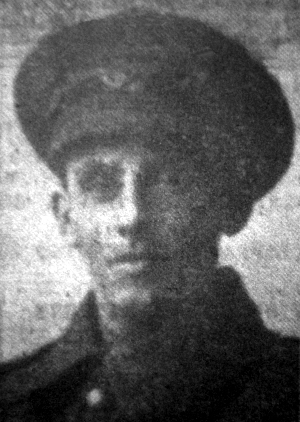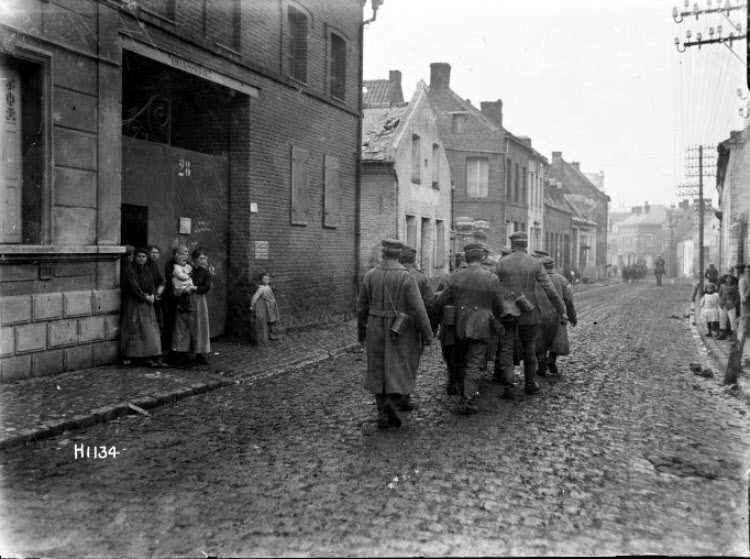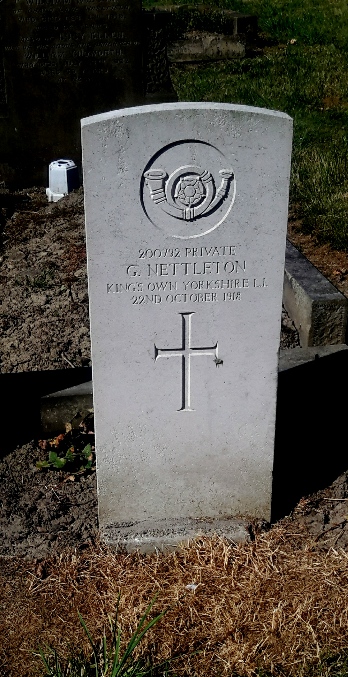
George Nettleton was born in Ossett on the 10th May 1889 and baptised at Ossett Holy Trinity Church on the 4th August 1889. He was the fifth son and eighth child of Robert Nettleton and his wife Elizabeth or Betsy (nee Roling) who married at Dewsbury All Saints Church on the 16th November 1873.
The couple had twelve children from their marriage, but one child died before April 1911. All of the family were born in Ossett. In 1901 George was living with his parents and his six brothers and four sisters on Back Lane, Ossett. His parents had lived here since their marriage and this was probably the house in which he was born.
In 1911, aged 21 years, he was still living with his parents, Robert and Betsy and four brothers and a sister in the same two-roomed home at 13, Ventnor Cottages, Back Lane, Ossett. Willie’s father Robert was a mill hand, but in 1911 was currently out of work, aged 57. George was a mill worker. George’s younger brother, William Nettleton, also served in the army in WW1 and lost his life.
George Nettleton’s army service record has not survived, but it is known that he enlisted at Ossett, and joined the King’s Own Yorkshire Light Infantry with service number 200792. He died at home of his wounds on the 22nd October 1918 and was posthumously awarded the British and Victory medals, but not the 1914/15 Star, indicating that he did not serve overseas before the 31st December 1915.
The 1/5th Battalion, Kings Own Yorkshire Light Infantry was a unit of the Territorial Force with HQ in Doncaster, serving with 3rd West Riding Brigade, West Riding Division. When war broke out in August 1914, the units of the Division had just departed for their annual summer camp, they were at once recalled to their home base and mobilised at once for war service, moving to Doncaster. In November they moved to Gainsborough and in February 1915 to York to prepare for service overseas, those men who had not volunteered for Imperial Service transferred to the newly formed 2/5th Battalion.
They proceeded to France, from Folkestone landing at Boulogne on the 12th of April 1915 and the Division concentrated in the area around Estaires. On the 15th of May the formation was renamed 148th Brigade, 49th (West Riding) Division. Their first action was in the The Battle of Aubers Ridge in May 1915. In 1916, they were in action in the Battles of the Somme. In 1917 they were involved in the Operations on the Flanders Coast and the The Battle of Poelcapelle during the Third Battle of Ypres. On the 2nd of February 1918 they transferred to 187th Brigade, 62nd (2nd West Riding) Division, absorbed the 2/5th Battalion and were renamed the 5th Battalion. They were in action during The Battle of Bapaume, The First Battle of Arras, The Battle of the Tardenois, The Battle of the Scarpe, The Battle of the Drocourt-Queant Line, The Battle of Havrincourt, The Battle of the Canal du Nord, The Battle of the Selle, The capture of Solesmes and The Battle of the Sambre.
At the Armistice the advanced units had crossed the Sambre and reached the Maubeuge-Avesnes road. The Division was the only Territorial formation to be selected to enter Germany and took over the area around Schleiden in December.
Private George Nettleton was probably wounded during the 62 Division action to capture the village of Solesmes. From the 1st to the 17th October 1918, 62 Division were out of the line, apparently in VI Corps Reserve, but were following up as the advance progressed so that by the 15th October, they were camped around Estourmel. That day, 62 Division HQ received orders to be ready to capture Solesmes and the high ground to the east of the river Selle on or about the 20th October 1918.
The River Selle at Solesmes was normally about 6 metres wide and 1.5 metres deep, with a muddy bed and steep banks, but was at this time swelled by heavy rains. Moreover, a demolished railway bridge had partially blocked the river and so flooded the area south of the village. The Selle flows south to north and joins the Escaut or Scheldt at Denain. An operation in two phases was envisaged:
Phase 1. Take Solesmes and the adjoining Saint-Python, including the crossing of the River Selle;
Phase 2. Move forward to take the high ground about 2 km beyond, which overlooks Romeries.
During the night of the 17th to 18th October 1918, 62 Division began to move forward from Carnières and Boussières to the front line just west of Solesmes, where it relieved a Guards brigade. The night of 19th to the 20th October saw the divisional Royal Engineers companies erecting, under fire, twelve assault bridges and two pontoon bridges for artillery, across the swollen river, some upstream and others downstream of Solesmes/Saint-Python.
At the same time, the attacking force moved up to the start line near the villages from billets at Quiévy. Zero hour for Phase 1 was 2 a.m. on 20th October. Because there were French civilians in the villages, only shrapnel and machine gun fire (from which they could shelter) were permitted in the creeping barrage. There was fierce street fighting, but the whole of both Solesmes and Saint-Python was taken by 7.15 a.m.
Meanwhile, another brigade of 62 Division assembled at Quiévy and from there moved forward at 4 a.m. One battalion moved round the left and another round the right of the village. By this time the rising water had submerged the bridges across the Selle, but a crossing was made and by 7 a.m. positions were taken up on the start line for Phase 2 just east of Solesmes. A barrage opened at once and the attack on the high ground overlooking Romeries began. The objective was reached by 10 a.m. contact was made with the flanking divisions and a defensive front established.
After bombarding the new front line, the enemy counter-attacked at 4.15 p.m. but was repulsed. Solesmes and Saint-Python were bombarded during the night of the 20th to the 21st October 1918.1
The “Ossett Observer”, 2 had this short obituary for George Nettleton:
“The death took place at Shorncliffe camp military hospital, on Tuesday, of Private George Nettleton (29), of K.O.Y.L.I., of Ventnor-cottages, Back-lane, Ossett. The deceased soldier had been in France several times, and had been wounded and gassed, Before joining the forces, he worked at a Horbury athletic factory. Three of his brothers are serving, and another, Lance-Corporal Willie Nettleton, was killed in 1916.”

Above: German World War One prisoners passing local inhabitants, Solesmes, France, 1st Nov 1918.
Private George Nettleton, aged 29 years, son of Mr. and Mrs. Robert Nettleton, of 13, Ventnor Cottages, Back Lane, Ossett, died on the 22nd October 1918. He is buried at Row 7. Grave 8 in the Ossett (Holy Trinity) Churchyard, 3 Church Street, Ossett.

Commonwealth War Graves Commission Headstone (Photograph courtesy of local historian, Joan Smith)
References:
1. The British 62nd Division in the Great War – The Last Hundred Days
2. “Ossett Observer”, 26th October 1918